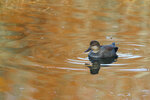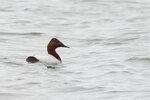




December is the peak month for bird watching at Capitol Lake. This time of year the lake has many waterfowl of many species, here for their winter vacation.
Most of these species breed on wetlands, ponds, and lakes throughout the interior of northern North America. When winter comes, these areas freeze and the swans, ducks and geese move to coastal areas. It’s hard for us to imagine, but for waterfowl Thurston County is their “banana belt.” And no local area is more popular than Capitol Lake.
For humans, there are paved walkways around the northern part of the lake and parts of the rest. Birders using wheelchairs and strollers like it here.
You can see the birds from many angles, but you probably will need binoculars or a telescope to identify specific species.
Many waterfowl species are out in the middle of the lake, spending their hours diving for food. One uncommon duck species, the Canvasback, can usually be found here. This diving duck has a chestnut head and neck with a distinctive sloping head and black bill. For males, the breast and rear are black, and the rest of the body is white. Females have a similar color pattern, but much paler colors.
Two closely related and similar duck species, Greater Scaup and Lesser Scaup, are also located out in the middle of the lake. Like the Canvasback, these are diving ducks that will be repeatedly diving, then resurfacing. They propel themselves underwater to the bottom, probing mud for various invertebrates (mollusks, crustaceans, and insects. (I wonder if they feed on the invasive New Zealand mud snail that has established itself in Capitol Lake).
Males of both species have a glossy black head, chest, and rear, and appear white in between. Females of both species are a rich brownish overall with a distinctive white patch next to the bill. The main way to distinguish the two species is the head profile – the Greater is rounded and the Lesser distinctively peaked. In good light, the Greater males head appears iridescent green and the Lesser male is a purplish iridescent.
Other ducks frequenting Capitol Lake are the many species of dabbling ducks. These ducks feed at or near the water’s surface. The most common, as you might suspect, is the Mallard but you will also find Northern Shovelers and Green-winged Teals. One species, the Gadwall, is less common and worth looking for. The body of males appears gray, but it’s actually a very beautiful pattern of gray, brown and black, with a distinctive black rump. The female appears similar to a female Mallard, speckled brown with a yellow bill.
All of these dabbling ducks will be located closer to shore, where they find vegetative food. Some of them feed by tipping bottoms up, lowering their heads underwater to feed. For other, shyer bird species, there are wild, undeveloped shorelines at Capitol Lake for feeding and resting.
Most winters, Capitol Lake is visited by Trumpeter Swans. I understand that last week there were some of these impressive visitors. They are probably just passing through on their way to other wintering areas, but they may stay around. These birds are unmistakable with their large white body, distinctive long and graceful white neck, and loud bugle-like calls, especially when they are flying.
Incidentally, you will also find gulls of several species on the lake, including Glaucous-winged Gull (the larger ones) and Ring-billed Gull (smaller ones). Gulls feed regularly along the marine shorelines, but they like to visit freshwater areas for bathing. Once they’ve washed off the saltwater, a gull often will fly to a perch and groom its feathers.
Waterfowl of both common and unusual species can be found at Capitol Lake. You can valiantly try to identify them all -- or you can just enjoy the diversty and abundance of winter visitors at Capitol Lake.
George Walter is environmental program manager at the Nisqually Indian Tribe’s natural resources department; he also has a 40+ year interest in bird watching. He may be reached at george@theJOLTnews.com
Photos for this column are provided by Liam Hutcheson, a talented 16-year-old Olympia area birder and avid photographer.
3 comments on this item Please log in to comment by clicking here
mkretzler
Thanks for this article. I'd like to offer more information about the Trumpeter swans. They have wintered in the middle lagoon in increasing numbers for the last several years. They usually arrive in early November and stick around into February. Last year, I counted 35 at the peak of their sojourn.
Sunday, December 10, 2023 Report this
rockyw98502
By golly, if you haven't just gone and outdone yourselves again George & Liam! Thanks for another interesting and enlightening column on wonderful birding opportunities right near downtown Olympia. Please keep up the great work on behalf of your readers and the always fascinating bird populations.
Betty Watson
Monday, December 11, 2023 Report this
BradPax
Super interesting, thanks!
Friday, December 15, 2023 Report this